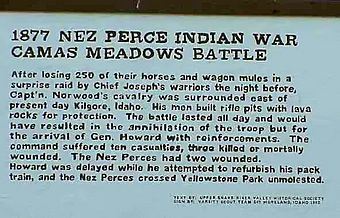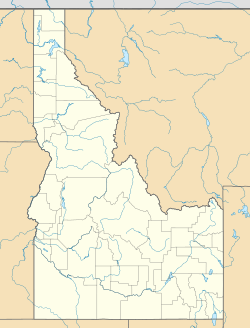Camas Meadows Battle Sites facts for kids
|
Camas Meadows Battle Sites
|
|

Camas Meadows sign, Idaho, 2003
|
|
| Location | Clark County, Idaho, USA |
|---|---|
| Nearest city | Kilgore, Idaho |
| Area | 80 acres (32 ha) |
| Built | 1877 |
| NRHP reference No. | 89001081 |
Quick facts for kids Significant dates |
|
| Added to NRHP | April 11, 1989 |
| Designated NHL | April 11, 1989 |
The Camas Meadows Battle Sites are two special places in Idaho. They are important because of a fight that happened there on August 20, 1877. This fight was between the Nez Perce people and the United States Army.
During this event, the Nez Perce took about 150 horses and mules from the army's camp. Later, they surrounded a small group of soldiers who were trying to get the animals back. The two battle sites are about 5 miles (8 km) apart in Clark County, Idaho.
In 1989, these sites became a National Historic Landmark. Now, they are part of the Nez Perce National Historical Park. This park includes many places that are important to Nez Perce history.
Contents
What are the Camas Meadows Battle Sites?
The Camas Meadows Battle Sites are made up of two main areas. Each area is about 40 acres (16 ha) in size. They are located northeast of Dubois, Idaho. You can find them off Clark County Road A-2, on the east side of Camas Creek.
The Army Camp Site
The first site is where the army set up their camp. It's found at about 44°21′11″N 111°53′06″W. This area was called Camas Meadows because of the many camas flowers that grew there. The streams in the area provided water, making the flowers bloom in an otherwise dry place. Most of the army's camp was between Camas Creek and Spring Creek. Even General Oliver Otis Howard had his tent on a small hill east of Spring Creek.
The Siege Site
The second site is where the soldiers were surrounded. This area is further northeast, at about 44°24′45″N 111°47′41″W. Here, a group of 50 soldiers, led by Captain Randolph Norwood, took cover. They used two low hills to protect themselves from the Nez Perce. The soldiers dug special holes called "rifle pits" to shoot from safely. You can still see these pits today.
What Happened at Camas Meadows?
The events at Camas Meadows were part of a bigger conflict called the Nez Perce War. This war happened because some groups of Nez Perce people did not want to move to a special area called a reservation. General Howard told them they had to move in May 1877. When they refused, the war began.
The Nez Perce War
A famous Nez Perce leader named Chief Joseph tried to lead his people to Canada. They hoped to find safety there. But first, they had to get away from the U.S. Army. The Nez Perce had a big fight called the Battle of the Big Hole on August 9–10. After that, they traveled south. They hoped to go around General Howard's army and reach Canada from a different direction. General Howard tried to stop them by getting to Camas Meadow first. However, he arrived on August 19, one day after the Nez Perce had already left.
The Army Camp Raid
The Nez Perce saw a chance to strike back. They decided to raid the army camp at Camas Meadow. They traveled for half the night. Just before dawn, they surprised the camp. They managed to take about 200 pack mules and several horses.
General Howard quickly sent three groups of soldiers to chase them. One of these groups was Captain Randolph Norwood's 50-man team. They went ahead of the others.
The Siege and Retreat
Captain Norwood's group soon found themselves surrounded by the Nez Perce. The soldiers had to dig rifle pits to protect themselves from enemy fire. They were trapped for several hours. Finally, General Howard's main army arrived. When the Nez Perce saw the larger force, they decided to leave.
The army then stopped to get organized again. Because of this, they lost track of the Nez Perce. The Nez Perce, even with fewer supplies, were not caught until six weeks later.



